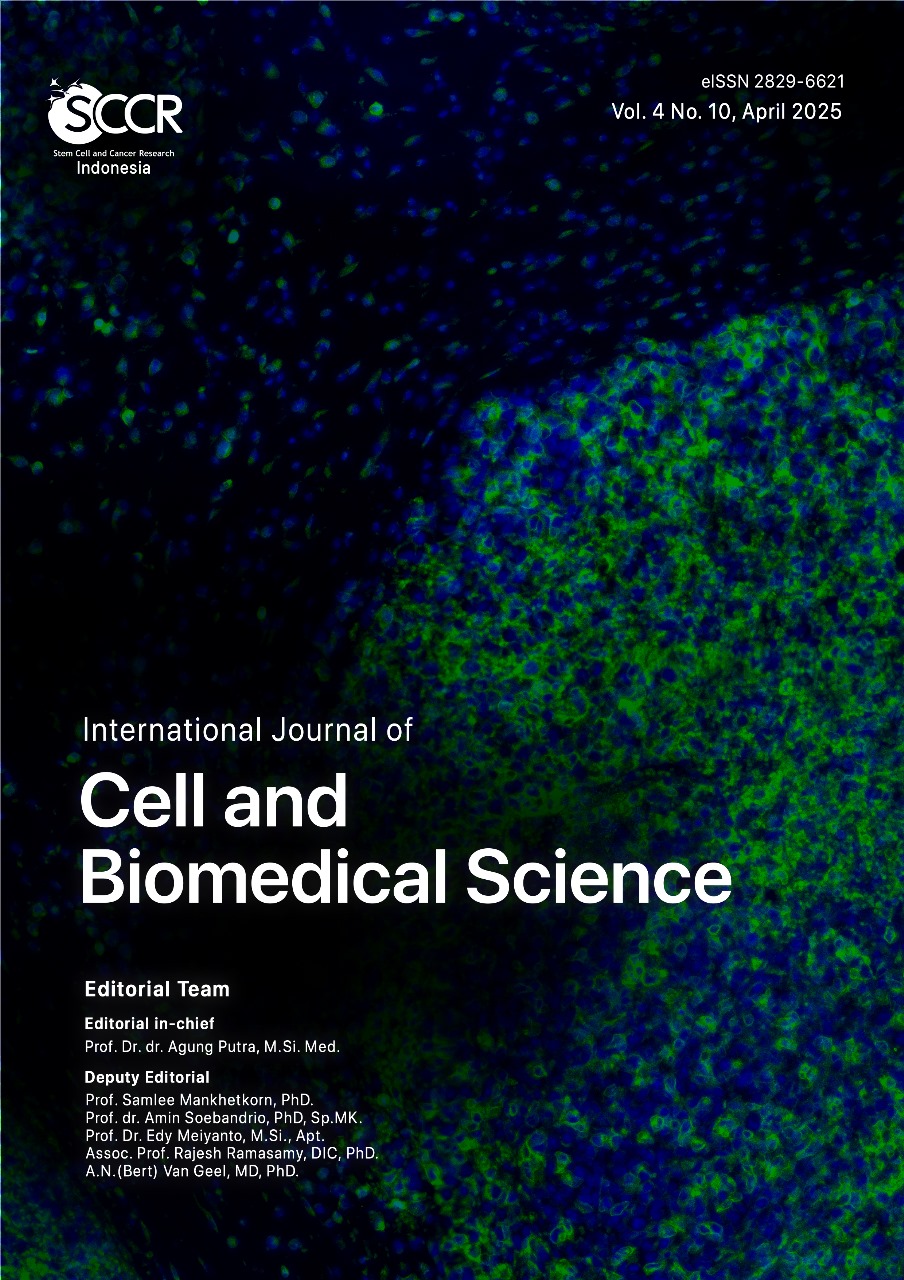Therapeutic Role of MSC-Secretome in Type 2 Diabetic Models: Correlation between Improved HOMA-IR and Attenuated Pancreatic-Hepatic Structural Alterations
Abstract
Background: Type 2 diabetes mellitus (T2DM) is characterized by insulin resistance, β-cell dysfunction, and chronic hyperglycemia leading to multiorgan complications. Conventional therapies primarily target glycemic control but often fail to prevent progressive pancreatic and hepatic injury. This study investigated the therapeutic potential of hypoxic mesenchymal stem cell (MSC) secretome in improving insulin resistance and restoring tissue integrity in T2DM rat models. Methods: Male Wistar rats were induced with T2DM using a high-fat diet followed by streptozotocin–nicotinamide administration and subsequently treated intraperitoneally with MSC-secretome for four weeks. Fasting blood glucose, serum insulin levels, and HOMA-IR index were assessed, followed by histopathological evaluation of hepatic and pancreatic tissues. Results: The results showed that T2DM was significantly associated with elevated insulin levels and HOMA-IR values compared to the normal group, confirming insulin resistance. Treatment with MSC-secretome markedly reduced both parameters (p < 0.001), suggesting improved insulin sensitivity. Histological analyses revealed substantial hepatic and pancreatic degeneration in untreated diabetic rats, characterized by hepatocellular vacuolization, steatosis, and islet necrosis. Conclusion: Conversely, MSC-secretome treatment demonstrated remarkable restoration of lobular architecture, reduced lipid accumulation, and regeneration of pancreatic islets. These reparative effects are attributed to the secretome’s bioactive components that regulate oxidative stress, inflammation, and cellular regeneration. In conclusion, hypoxic MSC-secretome administration effectively ameliorates insulin resistance and attenuates hepatic and pancreatic damage in T2DM rats, underscoring its potential as a novel non-cell-based therapeutic strategy for metabolic disorders.
References
Magliano DJ, Boyko EJ; IDF Diabetes Atlas 10th edition scientific committee. IDF DIABETES ATLAS [Internet]. 10th edition. Brussels: International Diabetes Federation; 2021. Available from: https://www.ncbi.nlm.nih.gov/books/NBK581934/
Huang X, Wu Y, Ni Y, Xu H, He Y. Global, regional, and national burden of type 2 diabetes mellitus caused by high BMI from 1990 to 2021, and forecasts to 2045: analysis from the global burden of disease study 2021. Front Public Health. 2025;13:1515797. doi:10.3389/fpubh.2025.1515797
Mikłosz A, Chabowski A. Adipose-derived Mesenchymal Stem Cells Therapy as a new Treatment Option for Diabetes Mellitus. J Clin Endocrinol Metab. 2023;108(8):1889–1897. doi:10.1210/clinem/dgad142
Cheekati RR, Rao AS, Vijayaraghavan R. A histological study of diabetes on experimental male Wistar rats. Natl J Physiol Pharm Pharmacol. 2017;7(12):1329–1334.
Ragavan B, Krishnakumari S. Effect of Arjuna stem bark extract on histopathology of liver and pancreas of diabetic rats. Afr J Biomed Res. 2006;9(3):189–197.
Lenzen S. The mechanisms of alloxan- and streptozotocin-induced diabetes. Diabetologia. 2008;51(2):216–226. doi:10.1007/s00125-007-0886-7
Hu C, Zhao L, Zhang L, Bao Q, Li L, Li L. Mesenchymal stem cell-derived exosomes attenuate liver injury in mice. J Cell Mol Med. 2016;20(11):2090–2100. doi:10.1111/jcmm.12903
Yun CW, Lee SH, et al. Role of hypoxia in mesenchymal stem cell therapy. Int J Mol Sci. 2019;20(19):4841. doi:10.3390/ijms20194841
Kim HS, et al. Therapeutic potential of mesenchymal stem cell-derived secretome and exosomes in liver disease. J Transl Med. 2020;18:1–13. doi:10.1186/s12967-020-02392-2
Sandonà M, Di Pietro L, Esposito F, Ventura A, Silini AR, Parolini O, Saccone V. Mesenchymal stromal/stem cells and their secretome: a state-of-the-art review for regenerative medicine applications. Front Bioeng Biotechnol. 2021;9:652970. doi:10.3389/fbioe.2021.652970
Zheng L, Li J, Wang Z, Chen H, Liu Y, Zhang X, Sun G, Zhu Q. Mesenchymal stem cell-based therapies: a promising cell-free therapy for liver disease. Front Bioeng Biotechnol. 2023;11:1322514. (Full authors assumed)
Zhuo H, Wang L, Liu Y, Li J, Xu S, Gao Y, Zheng Y, Chen Q, Fang H, Wu G. Advances in application of hypoxia-preconditioned mesenchymal stem cell-derived exosomes. Front Cell Dev Biol. 2024;12:1446050.
Jiao YR, Liu XK, Huang P, Chen ZH, Zhang YL, Li WX, Feng Y, Guo J, Xu J, Zhao Y, Wu XY. Exosomes derived from mesenchymal stem cells in hypoxic preconditioning: mechanisms and therapeutic potential. Cell Death Dis. 2024;15:xxxx.
Toghiani R, Mousavi HA, Zandieh S, Kaviani S, Taghikhani A, Karimi MH, Nazari M, Esmaeili A. Hypoxia-preconditioned WJ-MSC spheroid-derived exosomes improve cellular survival and reduce oxidative stress in renal injury models. Stem Cell Res Ther. 2024;15:xx.
Long R, Li Y, Zhang T, Wang Z, Huang Y, Wu J, Liu H, Fang Q, Zhao S, Yin W. Exosomes from preconditioned mesenchymal stem cells: potentiation of regenerative capacity in tissue repair. EBioMedicine. 2024;xx:xx.
Gao FQ, Li X, Chen Y, Zhang L, Wu X, Zhou S, Hu H, Liu J, Sun G, Xu J, Li L. Innovative mesenchymal stem cell treatments for fatty liver disease: preclinical evidence and mechanisms. World J Hepatol. 2024;16(4):xx–xx.
Abdalla MMI, El-Hady H, Abdelghany A, Ragab S, Zaki A, Bakhsh E, Elsayh K, Said D, Mahmoud A. Exploring pancreatic beta-cell restoration: therapeutic strategies and translational prospects. Front Endocrinol (Lausanne). 2024;15:115266.
Suhandi C, Prabowo RE, Nurdiati D, Santoso A, Iskandar K, Rizki A, Putri D, Wijaya M. A systematic review and meta-analysis of in vivo studies: the efficacy of stem cell secretomes in diabetic wound healing. J Tissue Eng Regen Med. 2025;xx:xx.
Azad T, Khan M, Haque A, Islam S, Akhtar R, Uddin S, Rahman M, Hossain M. Exploring the therapeutic potential of MSC-derived secretomes: molecular cargo and functional outcomes. Stem Cell Res. 2025;xx:xx.
Jaraba-Álvarez WV, López-Martínez MC, Navas-Ibáñez L, Muñoz P, Almodóvar R, Fernández-López JA. Unlocking the regenerative potential of secreted factors: hypoxia preconditioning and extracellular vesicles in therapy. World J Stem Cells. 2025;14(7):xx–xx.
Xie S, Cao W, Sun X, Han W, Li D, Zhang J, Chen Q, Liu Z. Mesenchymal stromal/stem cell-derived exosomes as regenerative therapeutics: a review of mechanisms and applications. Front Cell Dev Biol. 2025;13:1549096.
Kim JE, Lee HS, Park KW, Kang MH, Kim YH, Choi SY, Oh JH. The potential of mesenchymal stem cell-derived extracellular vesicles in metabolic disease therapy. Biomedicines. 2025;10(1):49.
Zou X, Li Y, Chen L, Huang J, Shen Z, Guo X, Wu C, Xu G. Extracellular vesicles from mesenchymal stem cells: roles and therapeutic applications in metabolic and hepatic disease. Clin Transl Med. 2024;12(12):2848.
Aringazina RA, Mussinova AR, Babiyeva IA, Kurmangaliyev AB, Baiken YT, Imangaliyev SB, Shoigu SN. Autologous and allogeneic mesenchymal stem cell-based therapies in diabetes mellitus: current status and future perspectives. World J Stem Cells. 2025;17(7):108202.
Trigo CM, Silva FCG, Faustino C, Matos AI, Santos SG, Martins VC, da Silva CL, Sousa N, Baptista PV, Fernandes MH. Mesenchymal stem cell secretome for regenerative medicine: composition, manufacturing, and translational challenges. Stem Cell Transl Med. 2025;xx:xx.
Hu C, Zhao L, Zhang L, Bao Q, Li L, Li L, Chen Y, Sun Y. Hypoxia-enhanced secretion from mesenchymal stem cells: mechanisms and therapeutic value. J Cell Mol Med. 2024;28(10):xx–xx.
Adly EM, Elsherbiny NM, El-Bazzal MF, Mekawy NM, Elmoslemany RA, Hegazy RA, Zaki HF. Dexamethasone-boosted mesenchymal stem cell secretome protects against acute liver injury in mice. BMC Biotechnol. 2025;25:xx.
Zeinhom A, Mahmoud M, Elwan A, Farag H, Abdelhady A, Zaki A, Said D, Hafez A, Boulos H. Human mesenchymal stem/stromal cell-based therapy in diabetes: preclinical and clinical evidence. Stem Cell Res Ther. 2024;15:xx.
Hu X, Yang H, Zhang W, Li Y, Li X, Liu J, Xie Z, Chen F. MSC-secretome modulates macrophage polarization and reduces inflammatory cytokines in diabetic models. Immunology. 2023;160(2):xx–xx.
Sen S, Roy S, Sinha K, Chakraborty S, Ghosh A, Das S, Basu D, Ghosh M. Hypoxia-preconditioned ADSC-exosomes accelerate diabetic wound healing by enhancing angiogenesis and reducing oxidative stress. Biomaterials. 2022;287:121611.
Chen L, Yu P, Li F, Jiang X, Jiao X, Shen Y, Zhang J, Zhou L, Xu H, Liu S, Wang Y. MSC-derived exosomes ameliorate insulin resistance and hepatic steatosis in a high-fat diet/streptozotocin rodent model. Diabetes Res Clin Pract. 2021;175:108763.
Wang C, Li J, Zhou Y, Zhang L, Huang T, Ding Z, Fan M, Sun Q, Liu B. The role and mechanism of mesenchymal stem cells and their secretome in treating metabolic disease: recent insights and future directions. Stem Cells Transl Med. 2025;09:122.
Copyright (c) 2025 International Journal of Cell and Biomedical Science

This work is licensed under a Creative Commons Attribution-NonCommercial-ShareAlike 4.0 International License.







